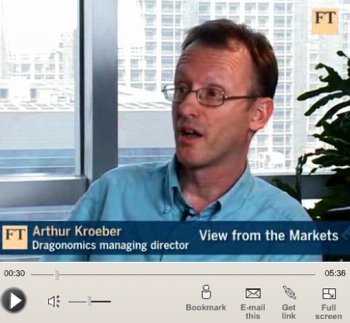Jim Cramer Time to Get Out of Stock Market a Buy Signal?
Stock-Markets / Global Stock Markets Oct 12, 2008 - 12:55 PM GMT

 Casey's Charts: Market mayhem has the Fed off balance
Casey's Charts: Market mayhem has the Fed off balance
“The Fed has resorted to new extremes in this financial crisis by selling off and lending its good assets, US Treasuries, in exchange for toxic waste. The result: the Federal Reserve's balance sheet has been completely restructured – including innovative off-balance-sheet hocus-pocus – and looks like it's headed for exhaustion.
“As the government's primary tool for stabilizing the US banking system, the Fed is now in dire need of a new source of lending to bail out other troubled banks.”
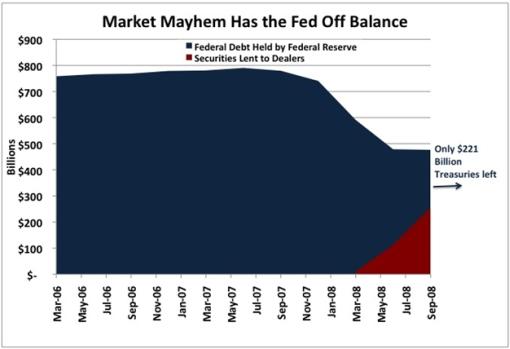
Source: Casey's Charts , October 8, 2008.
Bespoke: $700 billion and what it can buy
“Since the financial rescue package was signed into law last week, financial markets across the world have taken the pace of their declines to a higher gear. This has prompted people to ask what the Treasury is waiting for. Yesterday afternoon in a press conference, Secretary Paulson said that it ‘will be several weeks before our first purchase'.
“As shown in the chart below, when the TARP plan was first announced in September, that $700 billion was equal to less than 40% of the S&P 500 Financial sector's market cap. Today, that $700 billion represents over 55% of the sector's market cap. At this rate, by the time the Treasury opens up its wallet and starts spending that $700 billion, they might be able to buy the entire sector!”
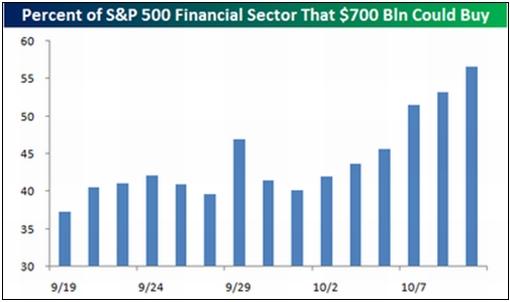
Source: Bespoke , October 9, 2008.
Bill King (The King Report): Adjusted monetary base and reserves soaring
“The Adjusted Monetary Base has soared from $873 billion on September 10 to $1.017 trillion as of Wednesday. The compound annual rate of growth since August 13 is 114.2%. It's not Weimar, but it is Argentinean.
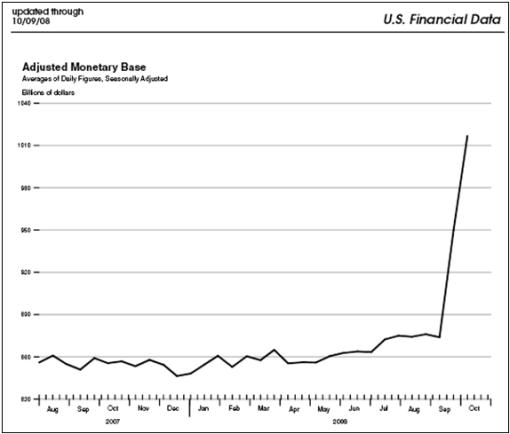
“Adjusted Reserves are up 768.1% compounded annually since July 30. This is beyond Argentina.”
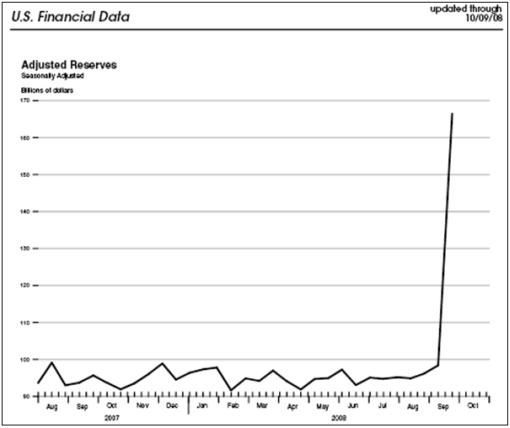
Source: Bill King, The King Report , October 10, 2008.
BBC News: US debt clock runs out of digits
“The US government's debts have ballooned so badly the National Debt Clock in New York has run out of digits to record the spiralling figure. The digital counter marks the national debt level, but when that passed the $10 trillion point last month, the sign could not display the full amount.
“The clock's owners say two more zeros will be added, allowing the clock to record a quadrillion dollars of debt. Douglas Durst, son of the late Seymour Durst – the clock's inventor – hopes to replace the Manhattan clock with its lengthier replacement early next year. For the time being, the Times Square counter's electronic dollar sign has been replaced with the extra digit required.”
Source: BBC News , October 9, 2008.
CNBC: Bernanke on the US economy
Click here for part 2 of the video.
Source: CNBC , October 7, 2008.
Asha Bangalore (Northern Trust): Sluggish labor markets – part of scenery
“Initial jobless claims fell 20,000 to 478,000 during the week ended October 4, 2008. Jobless claims filed following hurricanes Gustav and Ike led to a part of the advancing trend of claims seen in the past few weeks. The decline in the latest week reflects fewer initial claims in the hurricane stricken regions. Nevertheless, the elevated levels of both initial and continuing claims are consistent with levels seen in recessions.”
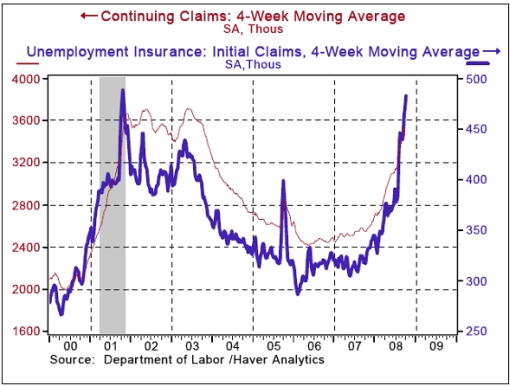
Source: Asha Bangalore, Northern Trust – Daily Global Commentary , October 9, 2008.
Zillow Survey: US homebuyers worried about interest rates
“I was a little surprised to hear it, but US adults who are in the market for a new home, or who plan to be in the market soon, are most concerned about interest rates.
“Interest rates were most often cited as a financial worry by US adults who plan to buy a home within the next two years, according to a Zillow survey, which was fielded by Harris Interactive. 68% of adults who plan to buy a home in the next two years said interest rates were a concern, while 63% said local property taxes were a worry, and 57% cited purchase price (respondents could choose more than one answer).
“Of those planning to buy a home within the next two years, 94% said they had at least one financial worry about buying a home. For people who plan to buy in three years or more, those worries changed a bit.”

Source: Katie Curnutte, Zillow , October 7, 2008.
Bespoke: We can't get no … satisfaction
“A Gallup poll released today showed that just 9% of Americans are satisfied with the way things are going in the United States. As shown in the chart below (from gallup.com), this is the lowest reading in history. Mid-1992 and mid-1979 were prior lows for the poll, but this is the first time satisfaction has dropped below 10%. These low levels are usually indicative that change is coming, and politically, that's just what we got in 1980 (Reagan) and 1992 (Clinton). There's no reason to believe the outcome will be any different in this election either at this point.”

Source: Bespoke , October 7, 2008.
Bespoke: Cost benefit of lower commodities
“The impact of commodity prices on consumer's wallets is now at its lowest levels of the year. With today's decline in oil and most other commodities (besides gold), the average consumer is now saving an average of 62 cents a day compared to the start of 2008. This is a complete reversal of the spike we saw early in the Summer when higher commodities were causing the average American to spend an extra $4.77 per day.”

Source: Bespoke , October 6, 2008.
Financial Times: Distressed debt level rises to five-year high
“The number of companies with debt trading at distressed levels, a leading indicator of default rates, hit a five-year high at the end of the third quarter as the deepening financial crisis put further pressure on prices, according to Moody's Investors Service.
“The ratings agency's distressed index, which measures the percentage of junk-rated issuers that have debt trading at more than 999 basis points over safe government bonds, has risen to 29.6% – the highest level since November 2002.
“This is more than a six-fold jump from the same time a year ago, when the index stood at 4.5% and nearly double the level at the end of the second quarter when it stood at 17.7%.
“Moreover, following the defaults of Lehman Brothers and Washington Mutual, the amount of defaulted dollar denominated investment grade debt globally has reached the highest levels since Moody's records began in 1994.”
Source: David Oakley and Anousha Sakoui, Financial Times , October 9, 2008.
CNN Money: Pensions lose $2 trillion
“Americans' retirement plans have lost as much as $2 trillion in the past 15 months, Congress' top budget analyst estimated Tuesday.
“The upheaval that has engulfed the financial industry and sent the stock market plummeting is devastating workers' savings, forcing people to hold off on major purchases and consider delaying their retirement, said Peter Orszag, the head of the Congressional Budget Office.
“As Congress investigates the causes and effects of the financial meltdown, the House Education and Labor Committee has heard from retirement savings and budget analysts on how the housing, credit and other financial troubles have battered pensions and other retirement funds, which are among the most common forms of savings in the United States.
“More than half the people surveyed in an Associated Press-GfK poll taken Sept. 27-30 said they worry they will have to work longer because the value of their retirement savings has declined.”
Source: CNN Money , October 7, 2008.
Financial Times: BofA to raise $10 billion in capital
“Bank of America, the largest US bank, said on Monday it would raise $10 billion in capital and halve its dividend in an effort to ride out the credit crisis.
“The moves came as the bank reported third quarter earnings of $1.2 billion – a third of the level of a year ago. Ken Lewis, Bank of America chief executive, said it was ‘prudent to raise capital to very substantial levels in this uncertain environment.
“‘These are the most difficult times for financial institutions that I have experienced in my 39 years of banking,' Mr Lewis said.”
Source: Deborah Brewster and Joanna Chung, Financial Times , October 7, 2008.
Bespoke: Global long term interest rates decline as investors seek shelter
“As the global credit crisis continues to roll, it's little surprise that investors have been seeking shelter in the relative safety of government bonds. As a result, the yields on these securities are sitting near their lowest levels of the last year. The largest collapse in yields by far has come in Australia (chart lower left) where the yield on its ten-year government bond has declined by nearly 200 basis points in the last four months. When a commodity based economy like Australia sees this big of a collapse in its long-term interest rates, it's a signal that the last thing on investors' minds is inflation.”
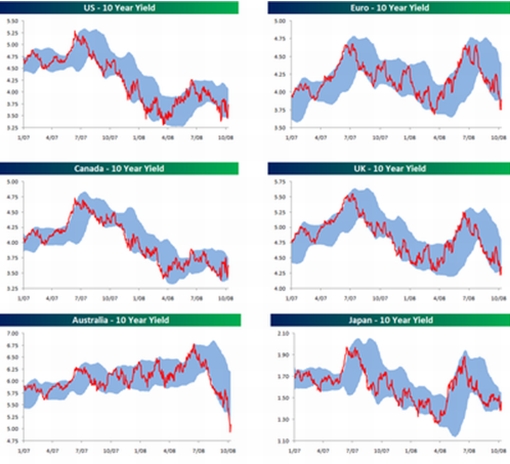
Source: Bespoke , October 9, 2008.
Neil McLeish (Morgan Stanley): Bullish on credit
“Morgan Stanley has turned bullish on credit markets for the first time since the start of the bear market, according to Neil McLeish, head of European credit strategy.
“‘Valuation is extreme, even on a 100-year view, sentiment reflects outright panic and fundamentals for higher-quality credit are improving due to official intervention,' he says.
“‘Investors should overweight investment grade credit, with a focus on the largest European banks and non-cyclicals.
“‘We continue to believe that 2007 represented not only the peak of a ‘vanilla' cycle that started in 2003 but also the peak of a 30-year ‘debt supercycle' that started in the early 1980s. The unwind of this supercycle should end with lower private sector leverage across the developed world and a smaller and less complex financial sector.
“‘However, we believe that credit markets are now pricing too high a likelihood of sustained debt deflation. Although policymakers have fumbled several times, we believe they will react more aggressively over the next few weeks and remind markets that the partial socialisation of credit risk should cushion the supercycle unwind for higher-quality credit.
“‘Nonetheless, we do not expect the real economy or earnings to trough until 2009. History suggests credit spreads reach their final peak only a couple of months before the final trough in the real economy, some time in the first half of 2009.'”
Source: Neil McLeish, Morgan Stanley (via Financial Times ), October 7, 2008.
Bespoke: Comparing this week to the ‘87 crash
“Most Dow stocks were down more this week than during the week of the ‘87 crash. As shown, GM was down 45%, AA was down 41%, BAC was down 39%, CVX was down 27%, and AXP was down 25%. Only two Dow stocks were down less than 10% this week: JPM (-9%) and GE (-0.32%). Maybe the most important takeaway is the returns these Dow stocks have had since the ‘87 crash. Who knows when, but we will go up again.”
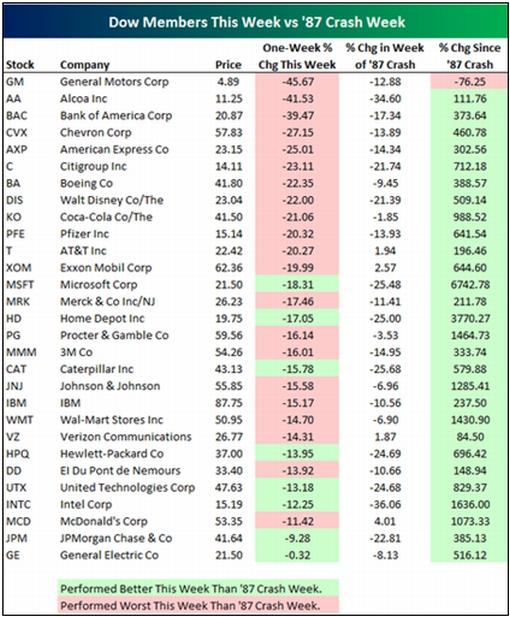
Source: Bespoke , October 10, 2008.
Bespoke: World equity markets – $25.9 trillion gone
“Here's one to take home with you tonight, although it might make it tough to keep your dinner down. Since last October, the value of stocks worldwide has fallen 41%, or $25.9 trillion. As shown in the chart below, Bloomberg's World Market Cap index has fallen from $62.5 trillion at its peak on October 31st, 2007 to its current level of $36.6 trillion. On an individual country basis, the US has lost by far the most at nearly $7 trillion. China ranks second at -$1.77 trillion, followed by the UK (-$1.72 trillion), Japan (-$1.54 trillion), and Hong Kong (-$1.47 trillion).”
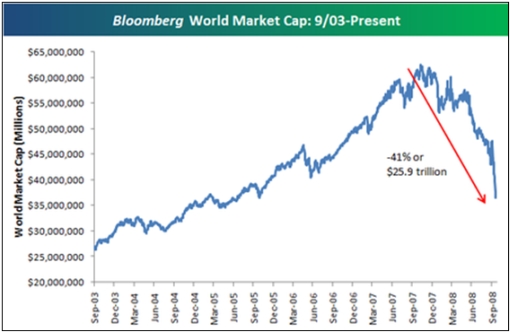
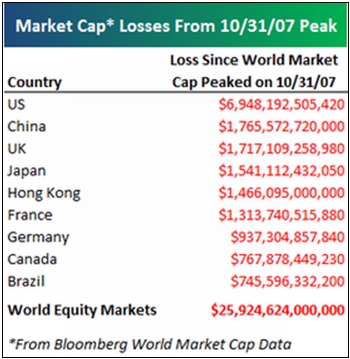
Source: Bespoke , October 8, 2008.
Richard Russell (Dow Theory Letters): Fear and panic spreading
“Fear and panic is starting to spread across Wall Street, Main Street and the world. Most investors have never seen market action like what we're seeing now. This is real bear market action such as we've not seen since 1973-74. I expect this downtrend to end with an all-out panic-type crash. That would clear the air and serve to reduce the huge inventory of stock for sale. When the store of ‘stock for sale' is emptied out, we will be close to the time when the institutional bargain hunters are ready to re-enter the market. That action will be characterized by a 90% up-day.”
Source: Richard Russell, Dow Theory Letters , October 7, 2008.
Barry Ritholtz (The Big Picture): Contrary Cramer buy call?
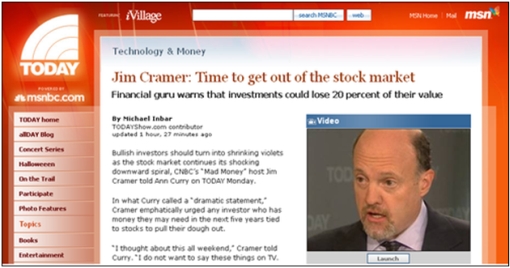
“As I have said in the past, I don't like to harp on any one person. I also don't want to be a Cramer stalker. But DAMN if that headline doesn't smell like a giant buy signal.
“The market down 30%, the VIX spiking to 56, and Cramer giving a panicky SELL on TV this morning. We have a 9,500 downside target, and the likelihood of an emergency action makes us want to get long – at least for a trade …
“We are putting a toe in the water here.”
Source: Barry Ritholtz, The Big Picture, October 6, 2008.
The Wall Street Journal: A street longtimer speaks
“Seth Glickenhaus, one of the few still on Wall Street who worked there during the Depression, thinks the stock market may be bottoming – temporarily.
“Mr. Glickenhaus first worked for a Wall Street firm in the summer of 1929, and founded his own money-management firm in 1938. He thinks battered stocks are due to rebound, but he worries they could fall again later.
“He is keeping 20% of his clients' money in cash, the highest level he remembers having.
“Now 94 years old, Mr. Glickenhaus still serves as chief investment officer of Glickenhaus & Co., which manages $1.8 billion for wealthy individuals and a few pension funds.
“‘You have one conspicuous difference between this and the 1929 break,' he said, using a common Wall Street euphemism to avoid saying ‘crash'.
“‘In the ‘29 break you had [President] Hoover and [Treasury Secretary] Andrew Mellon contracting all the way. They believed that it wasn't the role of the government to get involved. This time, the government is moving heaven and earth to reverse the cycle,' he said.
“Although Mr. Glickenhaus thinks stocks have fallen so far that a short-term rebound is likely, the economy is so weak and the financial system so damaged that a ‘recession or even possible depression will last for at least five years,' he warned.”
Source: E.S. Browning, The Wall Street Journal , October 6, 2008.
CNN Money: S&P: most dividend cuts in 50 years
“Dividend cuts in the third quarter took $22.5 billion out of the pockets of investors during what one Standard & Poor's analyst called the worst September for dividends in more than 50 years.
“Of the 7,000 or so publicly traded companies that report dividend information to S&P, 138 decreased their dividend during the third quarter of 2008 compared to 21 during the third quarter of 2007.
“That marks the worst September for dividends since S&P started keeping such records in 1956, said senior index analyst Howard Silverblatt.”
Source: CNN Money , October 3, 2008.
Bespoke: Withering stocks
“Below we highlight our trading range chart of the S&P 500 as well as its 10-day advance/decline line. People use the “crash” word very conservatively, but it's safe to say that the 25% selloff over the last nine trading days is indeed a stock market crash.”
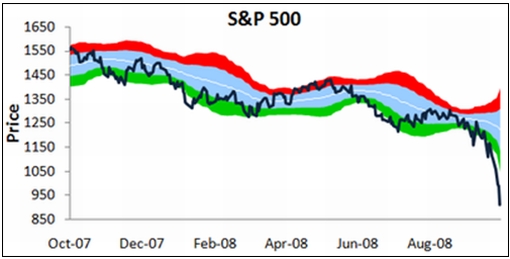
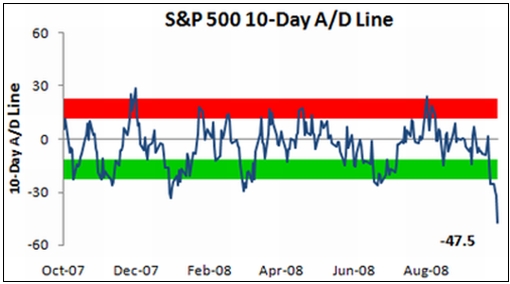
Source: Bespoke , October 9, 2008.
Eoin Treacy: Stocks very extended relative to 200-day moving averages
“Moving averages are a trend smoothing device that lag by definition. However, since a long-term moving average such as the 200-day is a mean level for any market, we are most interested when an instrument diverges from its mean for any significant length of time. These indicators provide useful barometers of how oversold both the Dow Jones and S&P500 have become.
“The S&P has never been so overextended relative to its 200-day moving average. Previous occasions when it got close in 1973, 1987 and 2002, all marked significant lows for the market. We have no evidence yet, that the S&P has found support but the more overextended it becomes, the sharper the covering rally is likely to be when the tide of sentiment begins to turn.
“The Dow Jones has only been more overextended relative to its moving average in 1938 and during the collapse of markets from 1929 to 1932. However, on every occasion, once the indicator bottoms, it has been a reliable signal that the market is close to an important low.”
Source: Eoin Treacy, Fullermoney , October 10, 2008.
Bloomberg: Mobius looking at Brazil, China, Russia after slump
“Mark Mobius said he sees bargains in Russia, China, Brazil, India, Turkey and South Africa and is ready to start buying after a record plunge in emerging-market stocks.
“‘We now have too many things to look at so we are picking the ones that are most down,' Mobius, who oversees about $30 billion in emerging-market equities at Templeton Asset Management, said in a Bloomberg television interview from Rome. ‘If you look at valuations, you can see these stocks are at a point where maximum pessimism is playing a big role. I think we'll be very happy a year or two from now.'
“Russia, China and Brazil have led this year's 49% plunge in the MSCI Emerging Markets Index, on speculation that the global credit crisis will spur a slowdown in demand for the commodities that drive developing nations' economies. The biggest annual slump on record dating back to 1987 left the gauge for developing markets valued at 8.7 times their average earnings, the cheapest since October 1998, according to data compiled by Bloomberg.”
Source: Daniela Silberstein and John Dawson, Bloomberg , October 9, 2008.
Fin24: JP Morgan – Buy South African gold shares
“JP Morgan said investors should buy South African gold stocks, especially companies such as the world's No. 5 producer, Harmony Gold, that are heavily exposed to the sharply rising rand gold price.
“‘We believe there to be a short-term trading opportunity in the South Africa gold sector that has the potential at worst to offer outperformance of the Johannesburg Stock Exchange (JSE),' JP Morgan analysts Stephen Shepherd and Allan Cooke said in a research note.
“Harmony and smaller producer DRDGold are the stocks most exposed to the rand gold price because all of their current production is sourced from South Africa, the analysts said.
“‘We believe there are substantial short-term gains in prospect through exposure to Harmony and, for investors with a higher risk appetite, DRDGold,' they said.
Source: Fin24 , October 9, 2008.
Bespoke: Europe just got 16% cheaper
“The US Dollar index staged another sharp rally today and is now up 16.35% from its lows back in March. The euro is down more than 16% from its highs earlier this year. For those that have plans to go to Europe anytime soon, at least it's 16% cheaper for now. Unfortunately for foreigners coming here, it's the reverse.”
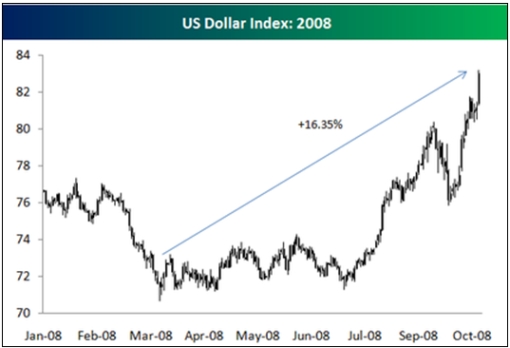
Source: Bespoke , October 10, 2008.
Bloomberg: Yen unbeatable as credit seizure kills carry trades
“The same credit market collapse that drove Lehman Brothers into bankruptcy and sent bank borrowing costs in Europe to record highs is making the yen unbeatable.
“Japan's currency was the best-performer in September and the only currency to appreciate against the dollar. Deutsche Bank AG, the biggest trader of foreign exchange, says the yen will rise 5% in coming months. New York-based Morgan Stanley is telling clients to buy the currency versus the euro and pound.
“After seven years of providing the cheapest source of funds for investors buying higher-yielding New Zealand dollars, Australian dollars and Brazil reais, the yen is appreciating as $584 billion of subprime mortgage-related losses force banks to restrict credit. It strengthened 4.4% on a trade-weighted basis in September, according to the Bank of Japan's effective exchange rate, the most since August 2007, when the seizure in capital markets began.
“‘We are in a multi-year trend reversal,' said Paresh Upadhyaya, a senior vice president at Putnam Investment in Boston. ‘We are going to see a global central bank easing cycle. The yen is the place to be in this environment of economic slowdown and heightened volatility.'”
Source: Ye Xie, Bloomberg , October 6, 2008.
Gulf News: Gulf central banks look to gold as uncertainty rises
“Central banks in the Gulf and elsewhere in the world will likely turn to gold as the global banking crisis boosts the metal's appeal as a buffer against dire economic conditions, industry sources said on Tuesday.
“With bank shares across the world plunging and the US dollar still unstable, central banks have no better option but to diversify their reserves into gold, considered the only alternative to the US dollar and euro.
“Analysts said demand from banks will likely affect gold prices, and retail consumers will resort to investing in bullion as well, particularly in exchange traded funds (ETFs), coins and small bars.
“‘Gold will definitely see a revival as a reserve asset for central banks. The main purpose for the central banks when investing is not to generate the highest possible returns, but to provide a safe and sound financial basis for the currency and the economy built on it,' Rolf Schneebeli, former head of the World Gold Council, told Gulf News.
“‘The only alternative to the US dollar is the euro. The pound sterling is probably not strong enough anymore. The yen and the Swiss franc, both strong currencies, do not have enough depth … Hence, gold is really the only alternative to the dollar and euro,' Schneebeli added.”
Source: Cleofe Maceda, Gulf News , October 7, 2008.
Financial Times: Central banks all but stop lending bullion
“Central banks have all but stopped lending gold to commercial and investment banks and other participants in the precious metals market, in a move that on Tuesday sent the cost of borrowing bullion for one-month to more than twenty times its usual level.
“The one-month gold lease rate rocketed to 2.649%, its highest level since May 2001 and significantly above its five-year average of 0.12%, according to data from the London Bullion Market Association.
“Gold lease rates for two, three and six months and for a year also jumped to levels not seen in the last seven years.
“Traders said the jump reflects the fact that central banks – mostly European – have almost completely stopped lending gold in the last few days and are not rolling forward old leases after maturity. This is because of fears that some borrowers might not repay their bullion loans if they are engulfed by the financial crisis.”
Source: Javier Blas, Financial Times , October 7, 2008.
Peter Spina (GoldSeek): Prospects for gold look excellent
“Gold's ultimate status as a money and a safe haven asset is showing its luster again today as the financial crisis escalates. Fiat money is flowing into gold as uncertainty and fear rocket to new heights. Volatility remains high across all markets and precious metals are not immune. This signals extreme fear across the globe and general sentiment is now quite harmonious in that things are set to get worse.
“I am expecting more aggressive monetary growth in the coming weeks and months. This will further debase the value and integrity of fiat currencies and capital looking to preserve its purchasing power will find safety in gold and silver. The relative value of currencies are immaterial at this point with only gold as the true barometer of the illness within the global fiat currency system.
“Physical demand has been unprecedented in recent weeks. Large premiums over spot prices with shortages of all kinds of bullion products being reported. Example, 100 ounce COMEX silver bars are being sold at $3+ above spot price where months ago the premiums was around $1/2 per ounce. US Silver Eagles are demanding $4-$6+ premiums over spot, months ago they would have commanded a $2 or so premium.
“Gold Eagles are going for $70 or more over the paper spot market price. This is the true market in the end and I do not believe in the full integrity of the gold/silver's paper markets' pricing mechanism at this time. I fully expect large price swings (extreme volatility), but the overall trend in the coming months will be to the upside.
“Gold and silver stocks continue to get battered with valuations becoming incredibly attractive. They are down with the general markets but in the near future I fully expect a vicious reversal in the precious metals stock sector. Gold and silver investments will attract the ever growing flight of capital out of general markets and investments. Short-term downside risks still do remain despite some incredible mid to long term prospects for mining stocks.”
Source: Peter Spina, GoldSeek , October 6, 2008.
Financial Times: Arthur Kroeber on China and the global financial crisis
“Arthur Kroeber, Dragonomics Research managing director and editor of China Economic Quarterly, discusses the effect the global financial crisis will have on China's willingness to liberalise its markets and on its exports. He also gives his outlook for GDP for the next few years.”
Source: Arthur Kroeber, Financial Times , October 5, 2008.
Did you enjoy this post? If so, click here to subscribe to updates to Investment Postcards from Cape Town by e-mail.
By Dr Prieur du Plessis
Dr Prieur du Plessis is an investment professional with 25 years' experience in investment research and portfolio management.
More than 1200 of his articles on investment-related topics have been published in various regular newspaper, journal and Internet columns (including his blog, Investment Postcards from Cape Town : www.investmentpostcards.com ). He has also published a book, Financial Basics: Investment.
Prieur is chairman and principal shareholder of South African-based Plexus Asset Management , which he founded in 1995. The group conducts investment management, investment consulting, private equity and real estate activities in South Africa and other African countries.
Plexus is the South African partner of John Mauldin , Dallas-based author of the popular Thoughts from the Frontline newsletter, and also has an exclusive licensing agreement with California-based Research Affiliates for managing and distributing its enhanced Fundamental Index™ methodology in the Pan-African area.
Prieur is 53 years old and live with his wife, television producer and presenter Isabel Verwey, and two children in Cape Town , South Africa . His leisure activities include long-distance running, traveling, reading and motor-cycling.
Copyright © 2008 by Prieur du Plessis - All rights reserved.
Disclaimer: The above is a matter of opinion and is not intended as investment advice. Information and analysis above are derived from sources and utilizing methods believed reliable, but we cannot accept responsibility for any trading losses you may incur as a result of this analysis. Do your own due diligence.
Prieur du Plessis Archive |
© 2005-2022 http://www.MarketOracle.co.uk - The Market Oracle is a FREE Daily Financial Markets Analysis & Forecasting online publication.




